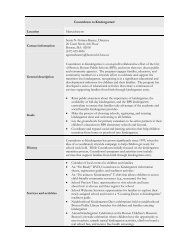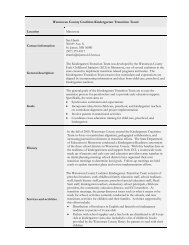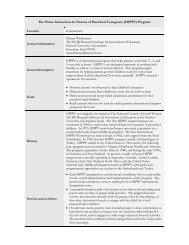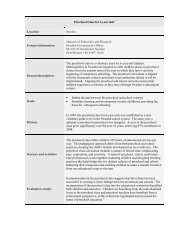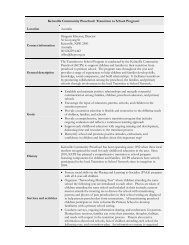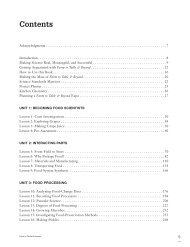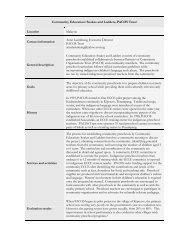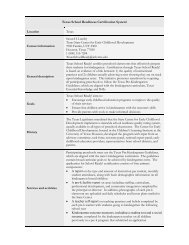Proceedings of the Fourth Annual Teachers College Educational ...
Proceedings of the Fourth Annual Teachers College Educational ...
Proceedings of the Fourth Annual Teachers College Educational ...
You also want an ePaper? Increase the reach of your titles
YUMPU automatically turns print PDFs into web optimized ePapers that Google loves.
Learning Science Systems with Graphic Computer Simulations<br />
Na Li, Mengzi Gao, Ha<strong>of</strong>ei Shen, Yuyang Guo, Daniel Lee,<br />
<strong>Teachers</strong> <strong>College</strong>, Columbia University, 525 W. 120 th street, New York, 10027<br />
Email: nl2284@tc.columbia.edu, mg3220@tc.columbia.edu, hs2670@tc.columbia.edu,<br />
yg2282@tc.columbia.edu, dyl2119@tc.columbia.edu<br />
Abstract: Graphic computer simulations have great advantages in teaching abstract<br />
system concepts. Instructional scaffolding is very essential for learners to benefit from<br />
<strong>the</strong>se simulation-based learning environments. In this project, multiple simulation models<br />
at different abstract levels are designed as learning materials teaching three ideal gas<br />
laws (a chemical system). 36 adult learners without strong background in science<br />
participated in a pilot study; 10 middle school students from a public school in NYC<br />
participated in <strong>the</strong> usability testing study; and 58 middle school students from a public<br />
school in NYC participated in our current study. Data from preliminary research show that<br />
a top-down function-centered scaffolding strategy could produce better learning<br />
performance than a bottom-up structure-centered scaffolding strategy; and learning tasks<br />
encouraging learners to model system causality can be very effective under <strong>the</strong> functioncentered<br />
scaffolding condition, but not under <strong>the</strong> structure-centered scaffolding condition.<br />
Research Background<br />
Studies have demonstrated that systems learning goes through several sequential stages before learners<br />
are able to grasp a network <strong>of</strong> mechanics-function relations (e.g.,Assaraf & Orion, 2005). Explaining<br />
mechanism and causality is usually difficult for learners especially when <strong>the</strong> systems have hierarchical<br />
levels (Duncan & Reiser, 2007). Computational modeling and visualizing technology makes it possible to<br />
show <strong>the</strong> invisible lower-level mechanism <strong>of</strong> systems, and allows inquiry-based instructional design<br />
(Wilensky& Resnick, 1999). One important pedagogical implication from <strong>the</strong>se studies is to provide<br />
hierarchical instructional scaffolding in <strong>the</strong> learning process and help learners iteratively modify <strong>the</strong>ir<br />
conceptual representations <strong>of</strong> a system (Liu & Hmelo, 2009).<br />
Instrument<br />
A computer simulation environment with three simulation models has been designed for this research<br />
project. The first simulation model is realistic visualizations <strong>of</strong> three ideal gas law phenomena. The<br />
second simulation is a gas molecular activity model which is more abstract, with which learners are able<br />
to conduct virtual experiments to test hypo<strong>the</strong>ses (one example, see Figure 1). The third simulation is an<br />
abstract flowchart model which <strong>the</strong> learners use to model causality and explain <strong>the</strong> mechanism <strong>of</strong> <strong>the</strong><br />
system (see Figure 2). These three simulations demonstrate <strong>the</strong> system function and mechanism at<br />
different abstract levels. Some techniques are used to reduce cognitive load and scaffold information<br />
integration a). Simulations can set to be displayed on separate pages or on <strong>the</strong> same page in any<br />
combination. If two simulations are displayed on <strong>the</strong> same page, <strong>the</strong>y are dynamically linked which<br />
means as <strong>the</strong> learner interact with one simulation, <strong>the</strong> o<strong>the</strong>r changes accordingly. b). The realistic<br />
simulation and <strong>the</strong> gas molecular activity simulation are functionally and structurally mapped, so it’s very<br />
easy for <strong>the</strong> learners to compare two models for cross-level reasoning.<br />
Figure 1: A concrete representation <strong>of</strong> ideal gas law phenomena & a more abstract molecular<br />
activity model.<br />
40



